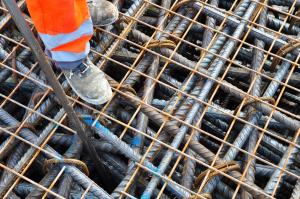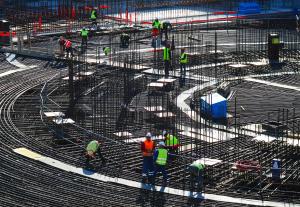Spider webs of steel
In the middle of the Tokamak Complex Seismic Pit a vast circle is now visible, part of the complex reinforcement work underway for the B2 foundation slab. Once in place, 16 levels of 40-millimetre-thick rebar will support the weight of the machine.

Four thousand tons of rebar for the Tokamak Complex basemat must be set into place precisely so that stress loads on the foundation, in normal as well as in accidental situations, are evenly distributed.
Bar after bar, level after level ... the detailed plans that guide the workers' movements are the result of hundreds of hours of calculations, modelling and simulations.
The first part of the process involves defining the buildings that the basemat will support. How big are they? How much do they weigh? And what safety functions—protection against radiation, confinement, seismic isolation—must they fulfil?
Equipment loads must then be taken into consideration as well as the forces the can result from cryostat thermal shrinkage, possible seismic events, and the normal or accidental vertical displacement of the Tokamak during operation.
In an average building, loads are measured in decanewtons; in the Tokamak Complex, meganewtons are used. These units describe the force required to give an acceleration of one metre per second to a mass of one thousand tons ... every second.
Computing this impressive amount of data into models gives rebar design specialists the quantity of steel necessary to guarantee the robustness and safety of each edifice. "The code tells us how much steel by linear metre of concrete is required, but it doesn't say much about how the rebar should be arranged," explains Laurent Patisson, head of the Nuclear Buildings Section at ITER.
Enter the structural analysis engineers, whose job it is to interpret the raw data and translate it into detailed, three-dimensional plans, which are then refined by draftsmen. Finally, contractor consortiums create detailed execution drawings based on in-house methodology.
"In the end, we need a 'buildable' design," stresses Laurent. "However dense the rebar, some access has to be preserved for the nozzle of the concrete pumps and the concrete vibrating tools."
For the most complex area of the basemat, where orthoradial and orthogonal reinforcement meets under the future machine, a 1:1-scale mockup is being implemented to the west of the Seismic Pit to test the rebar arrangement as well as the feasibility of concrete pouring.
This long and complex procedure will be regularly controlled by the French nuclear safety authorities (ASN) in order to guarantee that, even in the most improbable situations (accident, earthquake) the installation's confinement barriers will be preserved.



